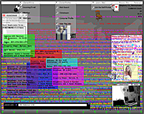
net.art as on-line activism
"Introduction: Over the last ten years, the Internet has embedded itself in the daily lives of a vast number of people. As a new telecommunication technology, it allows the common individual to engage in a cybernetic system that is globally networked. Today, however, a race goes on to establish the social dynamics of the Internet as a public arena. Will cyberspace become a highly monitored and regionalized control space or will the Internet retain its radical potential for independent endeavors and ideological exchange? The political implications of the Internet as a social network present rich issues for creative and critical cultural production.
The nature of the Internet as a network of connected computers to exchange information engenders a sense of liberty and freedom in the individual. Early in its development, mainframe teams established host-to-host protocols such as Telnet and File Transfer Protocol (FTP) that decentralized computer networking between independent users from the main frame.1 As the network grew it evolved into a new, democratic public sphere of communication via a globally expansive routing system and a vast array of on-line applications, amongst them electronic mail, and the world wide web.2 The individual was able to interface with an enlarged public, and a new dialogical space emerged.
Given the numerous forms of exchange possible via the Internet, on-line activity parallels Nancy Faser�s re-articulation of Jürgen Habermas�s public sphere as put forth in his 1962 book, The Structural Transformation of the Public Sphere. Habermas presents the public sphere as a bourgeois arena for exchange where citizens may discuss common affairs, a model based in the old town hall. In the essay, Rethinking the Public Sphere (1993), Nancy Fraser updates and expands the Habermasian public sphere beyond institutionalized public forums to include the market place and the domestic space (specifically in relation to domestic violence). Whereas, Habermas places market relations and domestic issues within the private sector, Fraser argues that, in doing so, these arenas of human interaction are restricted from legitimate public contestation.3 Fraser's re-articulation expands the public sphere beyond the bourgeois domain to a space that is open and accessible to all. As the Internet becomes increasingly commonplace and interweaves itself into general daily life in such forms as list serves, chat rooms, gaming communities, a host of multi-user domains it springs to life a multiplicity of publics by Fraser's definition.
Each public sphere is part of a civil domain that is governed by a set of laws and policies. Therefore, just as any civil, public space, the Internet must have its own set of policies that mirror those of our physical space. Amongst the on-line policies and regulations currently being established are decisions pertaining to appropriate policing and monitoring of cyber space, and determining the boundaries of privacy in a networked society.
The very nature of the Internet presents a highly efficient means of surveillance, as a networked electronic system that interfaces logical indexing machines, the computer. The ability to digitize nearly all types of records in conjunction with the computer's indexing and networking efficiency has established the database as the most advanced archival utility.
Use of such emergent technologies has been a long time goal by policing authorities. In the essay "The Body and the Archive," Allan Sekula traces in detail the use of photography to document, categorize and archive the human body by early criminology. As the body became a subject of the archive through photography, the fundamental problem of volume became apparent: The early promise of photography had faded in the face of a massive and chaotic archive of images. The electronic database's vast storage capabilities solves the problem of volume. Hence, the photograph once used to document the body and help establish identity is replaced by data. And as various types of data such as our home address, our shopping patterns, our level of institutionalized education, our employment and income, for example, are monitored and stored data becomes a basis of identity. The electronic network used to transfer data becomes a tool of investigation due to its potential for surveillance. The questions then arises: how far will police, federal and even corporate monitoring of the electronic sphere extend? How will we ever know its parameters? Is it a matter of trust or open systems or regulatory institutions? Where and how will the lines of personal and civil rights be drawn in a networked society?
The questions surrounding on-line privacy are complex and encompass a wide number of issues such as ownership, which in itself introduces a chain of other questions. It is impossible to present an answer to these involved questions as they will continue to arise. However, I do contend that unless non-governing independent groups protect the Internet as a space for independent production, dissemination and open discourse, the radical potential of the Internet will be consumed, largely through its very nature. Therefore, if there exists today an artist avant-garde, looking to merge art with daily social life, it is the growing number of socially active artist engaged in cyber resistance as a critical practice in which the network and the database represent tools for engagement.
I will present two primary forms of resistance as executed through two artist projects. First, TO INFORM: Brooke Singer exposes her own electronic data to enlighten a general public of one's freely available data. Second, TO SUBVERT: iSEE, a collaborative project between the Institute for Applied Autonomy and the Surveillance Camera Players makes use of the database structure to subvert the monitoring of the public sphere." Continue reading The Work of Artists in a Databased Society: net.art as on-line activism by Ricardo Miranda Zúñiga, NeMe.

